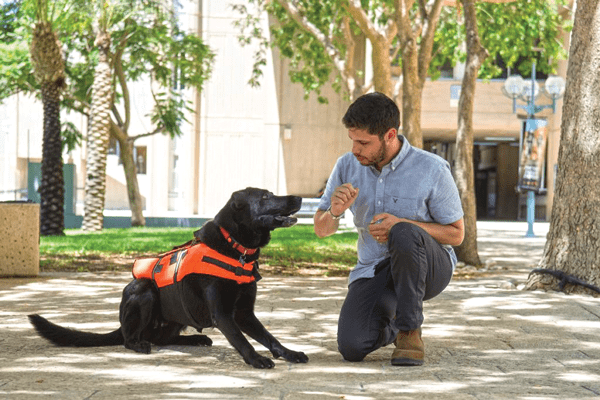I recently learned a new word: haptic. It refers to any technology involving the sense of touch, so vibration collars are technically “haptics,” and the signals you send when you press the button are “haptic cues.”
An exciting new development in the world of haptic cues is the “haptic vest” for dogs, designed by Israeli scientists at Ben-Gurion University of the Negev. In results presented this past summer at the Institute of Electrical and Electronics Engineers (IEEE) World Haptics Conference in Tokyo, the researchers reported that cues issued by gentle vibration motors in the vest were as effective as vocal cues.
The dog used for the study was Tai, a middle-aged Labrador- mix. Tai already knew four vocal cues for turn, lie down, come, and back up, so teaching him haptic cues for those behaviors was “not a large leap,” says lead author (and Tai’s owner) Yoav Golan, a Ph.D. candidate in mechanical engineering at Ben-Gurion University. The dog learned his first haptic cue – to spin, or turn in a circle – in about an hour. His second cue, to lie down, took longer to learn, partly because scientists had to adjust a motor on Tai’s hip so he could better feel the vibration. A third cue, come, took 15 minutes to learn.
If it pans out commercially, the vest would be able to give much more precise cues than a vibrating collar and could be used to teach a variety of behavior cues to a hearing-impaired dog. While a long way from arriving on the commercial market, the researchers tout future possible uses for the vest, including police and military work, as well as a way for speech-impaired humans to communicate to their dogs and hearing-impaired dogs to understand their humans’ communications.
Related Posts
Good Vibrations
Wolfwill Vibration Collar: The Negatives







Sounds interesting, however, I wonder why are humans attempting to tie a device to a Dog to ge them to react to a command? Why not learn from that Dog’s behavior? Learning that a dog’s behavior is critical in understanding the dog.
Sorry, this next culture seems to always want to tie something to an animal & shock it or stimulate it. Forgive me, but this appears to be the new response to everything in today’s culture, how fast can we do it?
By tying something on an animal You learn nothing about their body language! I don`t get it.
well said, Scott Baggett!
I agree with you Wm Scott Baggett. Many dogs respond to hand signal, that can also work for hearing impaired animals and people. Animals are totally in tune with body language and can sense feelings and moods – it’s a huge part of their survival. It’s more the human who needs to be vibrated into paying attention, not the animal.